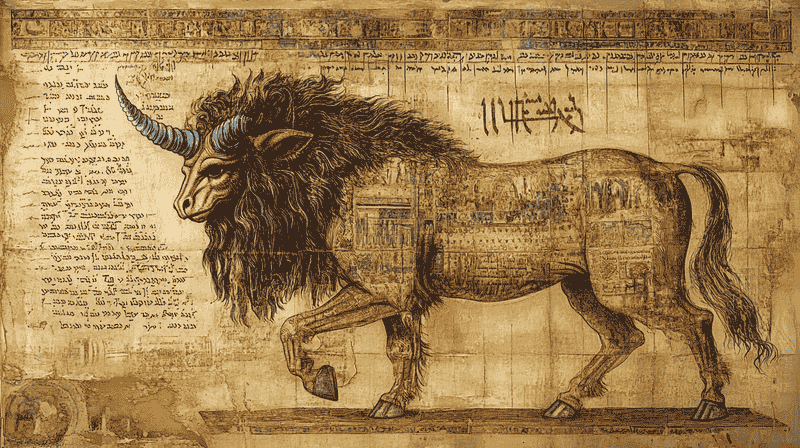Are Unicorns Mentioned In The Bible?
Alright, so let’s get straight to it—where exactly does the Bible talk about unicorns? If you’re flipping through the King James Version (KJV), you’ll find unicorns mentioned nine times. And not in some random, throwaway verse either. They show up in books like Numbers, Deuteronomy, Job, and even Psalms.
Here are a few standouts:
- Numbers 23:22 – “God brought them out of Egypt; he hath as it were the strength of an unicorn.”
- Job 39:9-10 – “Will the unicorn be willing to serve thee, or abide by thy crib? Canst thou bind the unicorn with his band in the furrow?”
- Psalm 92:10 – “But my horn shalt thou exalt like the horn of an unicorn: I shall be anointed with fresh oil.”
At first glance, this makes it sound like unicorns were just part of everyday life back then—wild, powerful, and definitely not the kind you’d find in a fairytale. But here’s where it gets interesting: later Bible translations don’t use the word "unicorn" at all. Instead, they swap it out for something a little more… well, realistic—words like wild ox, buffalo, or even rhinoceros.
So what happened? Was the KJV onto something that modern scholars missed? Or did the original Hebrew text mean something completely different, and "unicorn" was just a mistranslation?
It’s probably the latter. But before we get into translation errors, let’s take a closer look at the actual Hebrew word that kicked off this whole unicorn confusion.
The Hebrew Word ‘Re’em’ – Lost in Translation?
The Hebrew word re’em (רְאֵם). This is the word that got translated as "unicorn" in the King James Bible. But here’s the thing—re’em doesn’t actually mean unicorn. At all.
So what does it mean? Well, that depends on who you ask. In ancient Hebrew, re’em seems to refer to some kind of large, powerful, wild animal. Early translators weren’t exactly sure what creature it was, so when the Bible was translated into Greek (the Septuagint), they went with monokeros, which means “one-horned.” Fast forward to the Latin Vulgate translation, and they doubled down on that idea, using unicorns, which—you guessed it—became "unicorn" in English.
The problem? There’s zero evidence that biblical writers were describing a mythical, horse-like creature. More likely, re’em was referring to an actual animal that people at the time knew about. Some solid theories include:
- Aurochs (Wild Ox) – This one’s a strong contender. Aurochs were massive, wild cattle that roamed the Middle East and Europe for thousands of years. They had giant, curved horns and were known for being untamable—exactly how the Bible describes the re’em. Unfortunately, they went extinct in the 1600s, so no one’s getting a firsthand look at them anymore.
- Rhinoceros – Some scholars argue that since the Septuagint translated re’em as “one-horned,” maybe they were talking about a rhino. After all, it’s a big, strong, wild animal that fits the biblical descriptions of power and untamable strength.
- Oryx (Antelope with Big Horns) – Another possibility is the oryx, a type of antelope with long, straight horns. If you look at one from the side, it kinda looks like it has just one horn—so maybe ancient people just saw it from a weird angle and assumed?
So, what did we learn? The Bible never actually mentions unicorns (go figure). At the very least, not in the way we think of them today. The King James translators just rolled with what they had at the time, and the idea of a biblical unicorn was born.
Get Closer to God Today
4.9
Average Rating
|Over 5 Million Downloads
 Symbolism and Metaphor – More Than Just a Lost Animal?
Symbolism and Metaphor – More Than Just a Lost Animal?
Alright, so now that we know the biblical "unicorn" was most likely a wild ox (or maybe a rhino if you’re feeling adventurous), does that mean the whole thing is just a translation blunder? Not necessarily. Even if the re’em was a real animal, it could still carry some deeper meaning in Scripture.
Let’s look at how these so-called unicorns are actually used in the Bible. They’re always described as:
- Strong – “He hath as it were the strength of a unicorn.” (Numbers 23:22)
- Untamable – “Will the unicorn be willing to serve thee?” (Job 39:9)
- Majestic – “My horn shalt thou exalt like the horn of a unicorn.” (Psalm 92:10)
In other words, whatever this creature was, it wasn’t just some regular farm animal. It represented power, independence, and wild, unstoppable strength—kind of like how lions symbolize kingship or eagles represent freedom.
And that tracks with ancient cultures. In the ancient Near East, wild oxen (which were most likely the real re’em) were a big deal. They were seen as symbols of strength, divine power, and even royal authority. Kings would put them on their seals, warriors would compare themselves to them, and in some cases, people even believed they had a sacred, almost mystical quality.
So when the Bible talks about God having the strength of a unicorn (re’em), it’s not saying He’s some magical horse—it’s emphasizing His power, His might, and His ability to rule over all creation. When it says someone’s "horn will be exalted like a unicorn's," it’s not about an actual horn growing out of someone’s head—it’s about being lifted up in strength, honor, and victory.
And honestly? That makes way more sense than trying to squeeze a fantasy animal into Scripture.
Of course, this doesn’t mean people in ancient times never had myths about unicorn-like creatures. Almost every civilization has some version of a single-horned beast in its folklore. But in the Bible? It’s less about fantasy and more about imagery that made sense to the people at the time.
So, to recap: The biblical unicorn was most likely a wild ox, but the way it was used in Scripture had more to do with strength, untamable power, and divine authority than an actual four-legged mystery beast.
But how did we even get to the point where people started imagining medieval-style unicorns in the Bible? Well, blame the Middle Ages. Let’s talk about how this all got out of hand.
 How the Middle Ages Turned a Wild Ox into a Mystical Unicorn
How the Middle Ages Turned a Wild Ox into a Mystical Unicorn
So, if the re’em in the Bible was never meant to be a fairy-tale unicorn, how did we get from a wild, untamable ox to the glittery, horned horse of medieval legend? Simple—the Middle Ages had a thing for embellishing biblical imagery.
Once early translators turned re’em into “unicorn,” the idea of a one-horned biblical creature became set in stone. The Latin Vulgate, widely used in medieval Europe, reinforced this with “unicornis.” By the time medieval monks were copying manuscripts, “unicorn” was just an accepted fact.
The Middle Ages were completely wrapped up in symbolism, and unicorns quickly became a religious icon. People weren’t picturing a rough, muscular wild ox anymore—they imagined something pure, mystical, and elegant. Artists and storytellers ran with it, turning the biblical “unicorn” into a graceful, horse-like creature with a spiraled horn.
By the time the 12th century rolled around, unicorns had become a symbol of Christ Himself. Medieval bestiaries (kind of like nature encyclopedias mixed with theology) described unicorns as:
- Strong but gentle (just like Jesus)
- Only able to be tamed by a virgin (which they linked to the Virgin Mary)
- A representation of purity and divine power
Basically, they took a mistranslation and spun it into an elaborate religious metaphor. By the Renaissance, unicorns were everywhere in Christian art. You’d see them in stained glass windows, illuminated manuscripts, and even royal crests.
So, by the time people actually started translating the Bible with better linguistic tools (i.e., realizing re’em meant "wild ox"), the unicorn myth had already gone way too far to pull back.
And that’s why, even today, some people still think unicorns are in the Bible. We stuck with it because, for hundreds of years, people genuinely believed they were.
 How Modern Scholars Finally Debunked the Biblical Unicorn
How Modern Scholars Finally Debunked the Biblical Unicorn
Alright, so at this point, the medieval world had completely run with the unicorn idea—so much so that it became common knowledge. But as biblical scholarship advanced, linguists, historians, and archaeologists started asking a simple question:
“Wait… was the Bible actually talking about unicorns?”
And, well, the answer was a resounding no.
Instead of just accepting centuries-old translations, scholars went back to the original Hebrew manuscripts. That’s when they realized that the word “unicorn” in the King James Bible came from re’em, which never meant a single-horned horse. Instead, it pointed to a strong, untamable wild ox—a far cry from the mystical creatures people imagined.
Scholars also looked at how other ancient cultures translated the Bible. The Greek Septuagint (written way before the Middle Ages) translated re’em as monokeros (one-horned), which might explain how the whole unicorn idea started. But when you compare it to other historical records, it’s clear that people weren’t talking about a mythical beast—just a powerful animal with impressive horns.
Fun fact: We have ancient Assyrian carvings of wild oxen that match the biblical descriptions of the re’em. These animals were huge, untamable, and had massive curved horns. Scholars now believe that biblical writers were referring to these creatures, not some magical, horned horse.
As biblical translations improved, newer versions of the Bible started correcting the mistake. Instead of "unicorn," most modern Bibles now say wild ox or something similar. Here’s how some of those famous unicorn verses look today:
- King James Version (KJV) – "God brought them out of Egypt; he hath as it were the strength of a unicorn." (Numbers 23:22)
- English Standard Version (ESV) – "God brings them out of Egypt and is for them like the horns of the wild ox."
- New International Version (NIV) – "God brought them out of Egypt; they have the strength of a wild ox."
See the difference? No more unicorns—just a powerful, real-world animal that people in biblical times actually knew existed.
So, Was There Ever a Biblical Unicorn?
Short answer? Nope. The "unicorn" in older Bible translations was just a misunderstanding based on ancient word choices. The Bible wasn’t describing a fantasy animal—it was talking about a real, untamable animal, most likely an auroch or another kind of wild ox.
But even though the unicorn myth is busted, that doesn’t mean the Bible loses its impact. If anything, this whole thing just shows how important it is to understand historical context when reading Scripture. Words change, meanings evolve, and sometimes, a simple translation slip-up can lead to centuries of confusion.
Get Closer to God Today
4.9
Average Rating
|Over 5 Million Downloads
Our BibleChat Community Questions
Are unicorns mentioned in the Bible?
Yes—but only in older translations like the King James Version (KJV). The word “unicorn” appears several times in the KJV, but modern Bible translations have corrected this to “wild ox” or similar animals. The original Hebrew word used in these verses, re’em, referred to a real, untamable animal—most likely an auroch (an extinct type of wild cattle), a rhinoceros, or a large antelope. So while the word “unicorn” appears in some versions, the Bible wasn’t actually talking about a mythical one-horned horse.
What does a biblical unicorn look like?
If we’re going by what the Bible actually meant (instead of the medieval myth), then a biblical “unicorn” would look like a massive, powerful wild ox—not the sparkly white stallion of fantasy stories. The auroch, a giant species of wild cattle that went extinct in the 1600s, is the best guess for what the re’em actually was. Some have suggested the rhinoceros or oryx (a type of antelope), both of which have impressive horns and match the descriptions of strength and untamable nature found in biblical references.
Where are unicorns mentioned in the Bible?
In the King James Version, unicorns appear in:
- Numbers 23:22 – "God brought them out of Egypt; he hath as it were the strength of a unicorn."
- Numbers 24:8 – "He hath as it were the strength of a unicorn…"
- Deuteronomy 33:17 – "His glory is like the firstling of his bullock, and his horns are like the horns of unicorns…"
- Job 39:9-10 – "Will the unicorn be willing to serve thee, or abide by thy crib? Canst thou bind the unicorn with his band in the furrow?"
- Psalm 22:21 – "Save me from the lion’s mouth: for thou hast heard me from the horns of the unicorns."
- Psalm 29:6 – "He maketh them also to skip like a calf; Lebanon and Sirion like a young unicorn."
- Psalm 92:10 – "But my horn shalt thou exalt like the horn of an unicorn: I shall be anointed with fresh oil."
- Isaiah 34:7 – "And the unicorns shall come down with them, and the bullocks with the bulls…"




